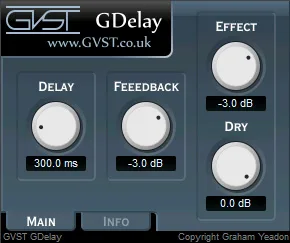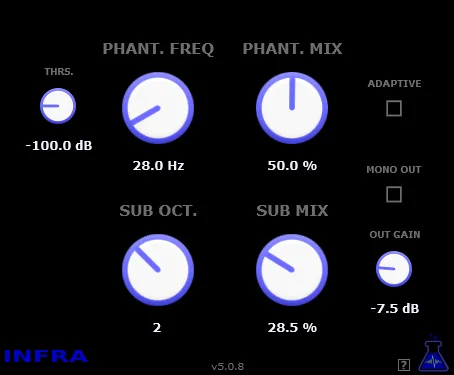In the world of music production, effects play a key role in shaping a unique sound, creating space, and adding dynamics to tracks. Among the many sound processing tools, the delay effect holds a special place. It allows you to duplicate sound with a time shift, creating echoes, rhythmic repeats, or a dense atmospheric background. The correct use of delay can transform a dry signal into something deep, captivating, and multi-faceted.
Introduction to GDelay from GVST
GDelay is a simple but powerful digital delay plugin developed by the renowned author GVST. GVST has gained popularity for creating functional and effective sound processing tools that are often free or available for a symbolic price. GDelay is a prime example of their philosophy: to provide musicians and sound engineers with the necessary tools without unnecessary complexity.
This plugin focuses on the basic function of digital delay with feedback, which is the basis for creating most classic and modern delay effects, from light echoes to psychedelic sound loops.
How does GDelay work?
The principle of GDelay is based on the digital duplication of the incoming audio signal and its playback after a certain period of time. A key feature of the plugin is the feedback function, which allows the processed signal (with added delay) to be fed back into the delay input. This leads to multiple repeats, the intensity and duration of which depend on the feedback settings. This mechanism allows you to create both barely noticeable echoes, imitating echoes in space, and long, blurred repeats, which turn into self-excitation at high feedback levels.
Main parameters of GDelay
The GDelay interface is extremely concise and intuitive, making it accessible even for beginners. The effect is controlled with only four main parameters:
-
Feedback: This parameter controls the percentage of the processed signal that is returned to the delay chain. High Feedback values lead to more repeats and their slower decay. At 100% and above, the plugin can start to self-excite, creating interesting experimental sounds.
-
Delay: Sets the time between the original signal and the first repeat, as well as between subsequent repeats. This parameter can be adjusted in milliseconds or synchronized with the tempo of your project (if the host program supports it). The Delay setting allows you to create both short, dazzling echoes and long, spatial repeats.
-
Dry (Dry Signal): Adjusts the volume of the original, unprocessed signal passing through the plugin. Allows you to control the balance between the “clean” sound and the added effect.
-
Effect (Processed Signal): Sets the volume of the processed signal — the delay repeats themselves. Along with the Dry parameter, Effect allows you to precisely mix the effect with the initial sound.
Who is this plugin for?
GDelay will be a great addition to the arsenal of any musician, sound engineer, or producer, regardless of the genre they work in. It’s ideal for adding space to vocals, guitars, synthesizers, and drums. With GDelay, you can easily create classic “slapback” echoes for guitars, rhythmic pulsations for synthesizer parts, atmospheric backing tracks, or deep, dub repeats for bass lines or percussion. Its simplicity makes it an ideal tool for quickly setting up delay without delving into complex menus and a multitude of obscure parameters.
Technical features and compatibility
The GDelay plugin is available in VST format, which ensures its compatibility with the vast majority of modern digital audio workstations (DAWs) on the market. One of the important advantages is its cross-platform nature: GDelay is supported by Windows operating systems (both 32-bit and 64-bit versions), macOS and Linux. This makes it accessible to a wide range of users, regardless of their favorite operating system. The plugin is distinguished by low CPU resource consumption, which allows it to be used in large projects without significant system load.
In general, GDelay from GVST is a reliable, simple, and effective tool for adding digital delay to your audio recordings. Its intuitive interface and basic parameters allow you to quickly get the desired result, and its wide compatibility makes it a universal solution for any studio. Try GDelay if you’re looking for a quality and free delay that just works.



